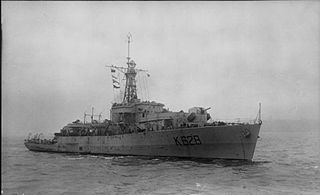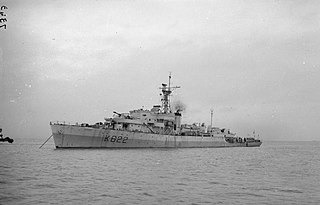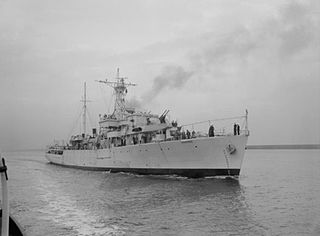
HMS Loch Alvie was a Loch-class frigate of the Royal Navy, named after Loch Alvie in Scotland. She was ordered by the Royal Navy during World War II, but did not see action with them, having transferred to the Royal Canadian Navy before commissioning. After the war she returned to the Royal Navy and would pass in and out of service until 1963.

HMS Loch Insh was a Loch-class frigate of the Royal Navy, named after Loch Insh in Scotland. She was built by Henry Robb of Leith and launched on 10 May 1944. After service at the end of World War II she was decommissioned, but reactivated in 1950 and served, mostly in the Persian Gulf, until 1962. The ship was sold to the Royal Malaysian Navy in 1963 and renamed KD Hang Tuah (F433). She was scrapped in 1977.

HMS Loch Killisport (K628/F628) was a Loch-class frigate of the British Royal Navy, named after Loch Killisport in Scotland. Launched in 1944, the ship was not commissioned until July 1945, and served in post-war repatriation operations in the Far East until decommissioned in April 1946. During this time Prince Philip was an officer on board this ship. Recommissioned in 1950 she served in the Home Fleet for two years, before being extensively modernised for service in the Persian Gulf and Far East. Decommissioned in August 1965, she was sold for scrapping in 1970.

The Loch class was a class of anti-submarine (A/S) frigate built for the Royal Navy and her Allies during World War II. They were an innovative design based on the experience of three years of fighting in the Battle of the Atlantic and attendant technological advances. Some shipyards had trouble building these larger ships, which led to widespread use of the Castle-class corvette, introduced around the same time.

HMS Bigbury Bay was a Bay-class anti-aircraft frigate of the British Royal Navy, named for Bigbury Bay in Devon.
HMS Wigtown Bay was a Bay-class anti-aircraft frigate of the British Royal Navy. She was named for Wigtown Bay in Galloway.

HMS Burghead Bay was a Bay-class anti-aircraft frigate of the British Royal Navy, named for Burghead Bay in Morayshire.

HMS Carnarvon Bay was a Bay-class anti-aircraft frigate built for the Royal Navy during World War 2.
HMS Enard Bay was a Bay-class anti-aircraft frigate of the British Royal Navy, named for Enard Bay in Caithness.
HMS Largo Bay was a Bay-class anti-aircraft frigate of the British Royal Navy, named for Largo Bay in Fife.
HMS Padstow Bay was a Bay-class anti-aircraft frigate of the British Royal Navy, named for Padstow Bay on the northern coast of Cornwall. Commissioned in 1946, she served on the American and West Indies Station only until 1947 before being put into reserve, and then sold for scrapping in 1959.
HMS St Austell Bay was a Bay-class anti-aircraft frigate of the British Royal Navy, named after St Austell Bay on the south coast of Cornwall. In commission from 1945 until 1956, she served in the Mediterranean Fleet and on the America and West Indies Squadron.
HMS St Brides Bay was a Bay-class anti-aircraft frigate of the British Royal Navy, named for St Brides Bay in Pembrokeshire. In commission from 1945 to 1961, she served in the Mediterranean and Eastern Fleets, seeing active service in the Korean War.
HMS Start Bay (K604/F604) was a Bay-class anti-aircraft frigate of the British Royal Navy, named for Start Bay in Devon. In commission from 1945 to 1946 in the Mediterranean Fleet, she spent most of her career in the Reserve Fleet.
HMS Tremadoc Bay was a Bay-class anti-aircraft frigate of the British Royal Navy, named for Tremadoc Bay in north Wales.

HMS Widemouth Bay was a Bay-class anti-aircraft frigate of the Royal Navy, named for Widemouth Bay in Cornwall.

HMS Surprise was a Bay-class anti-aircraft frigate of the British Royal Navy. In commission from 1946 to 1965, she served in the Mediterranean Fleet as a Despatch Vessel for the Commander-in-Chief. Although principally employed for the use as a yacht by the CinC, Surprise was also deployed in its operational role as an anti-aircraft frigate and was allocated to the Haifa Patrol for a brief period in 1948. The archaic term "Despatch Vessel" was replaced by "Flag Frigate" in 1961.

HMS Dalrymple was a Bay-class anti-aircraft frigate of the British Royal Navy, which served as a survey ship, mostly in the Persian Gulf, from 1948 until 1965. She was completed to deal with the large numbers of uncharted wrecks and mines around the British Isles as a result of World War II. For this purpose she was fitted for minesweeping. She was named for the pioneering Hydrographer of the Admiralty Alexander Dalrymple (1737–1808).
HMS Dampier was a survey ship of the Royal Navy, named after the explorer, author and privateer, William Dampier (1652–1715). Originally intended as a Bay-class anti-aircraft frigate, the ship was in commission from 1948 to 1968, spending her entire career based at Singapore, carrying out survey work.

HMS Loch Fyne was a Loch-class frigate of the British Royal Navy, built by the Burntisland Shipbuilding Company Ltd, Burntisland, Fife, Scotland, and named after Loch Fyne in Scotland. The ship was launched in 1944, and served at the end of World War II. Recommissioned in 1951, she served in the Persian Gulf and was scrapped in 1970.











